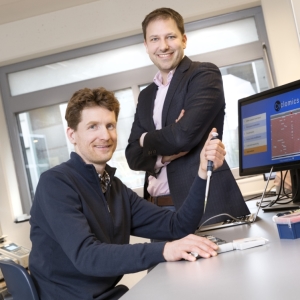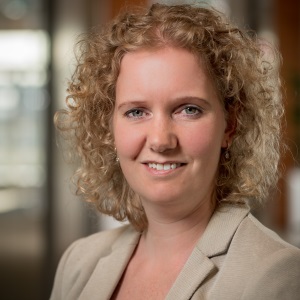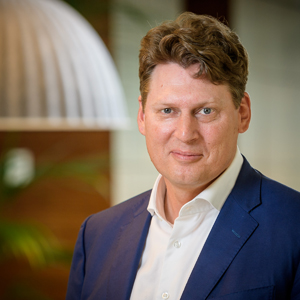
Scientists who decide not to publish papers, but to explore whether their discovery is the basis of a company. That’s the path taken by Cyclomics, the start-up of Wigard Kloosterman and Jeroen de Ridder.
In autumn 2017, Cyclomics won the Venture Challenge, a competition for start-ups in life sciences. At the start of the same year, they discussed the idea of the company for the first time during a lunchtime stroll. Kloosterman is a research group leader and molecular biologist. He studies the DNA of tumours on the basis of DNA sequencing technology in the genetics department. De Ridder has a background in bioinformatics: ‘With the arrival of the nanopore sequencer, we found ourselves asking: what more can we do with this?’ With this technology, a machine pulls a DNA molecule through a microscopic hole – a nanopore – and reads the DNA sequence at the same time. ‘We then came up with the idea of detecting tumour DNA molecules in the blood. Then we can see if someone has a tumour by looking at their blood. That’s one of the big questions in oncology: how can we detect tumours in good time and non-invasively? Kloosterman: ‘It’s about miniscule quantities – mere dozens of molecules. You need a very sensitive sniffer dog, which is where the nanopore sequencer comes in. We came up with a new application for existing technology.’
Patent Attorney
Initial experiments revealed that the discovery had potential. Then, as it happened, came the remark from the UMC: start thinking about which discovery would be good to market. They went and pitched their idea a load of times and, logically, received a load of constructive feedback, as a result of which they were able to fine-tune it. At that time, they also contacted a patent attorney from V.O. Kloosterman: ‘He figured out the essence of the thing extremely quickly and was soon able to make a decision about patent-worthiness. He forced us to differentiate between the main aspects and subsidiary aspects, and helped us to define what the real discovery was.’
Investors needed
‘As a scientist, you convey knowledge through articles,’ De Ridder explains. ‘Actually, it’s a bit like throwing it over the fence. But often nothing happens with it. So you need to do something yourself if you want to have an impact, with a company for example.’ Kloosterman: ‘The Venture Challenge was a sort of pressure cooker of two three-day sessions, where all sorts of questions arose. Where do you create value for the society? Who is the customer? The doctor or the patient? How do you earn money with it? What is your real product? It was a coaching programme with a competition. The main thing you learn here is actually how to pitch for investors.’
Now it begins
The first investors have since expressed their interest. De Ridder: ‘Now we need to create a company that attracts investors. We need a lot of money in order to make a solid product that also works in a clinical environment. There’s an incubator environment at the UMC where we will be working for one day a week, and a full-time postdoc. After that, more staff members will be needed for further validation work. Now we need to show it to the world.’

